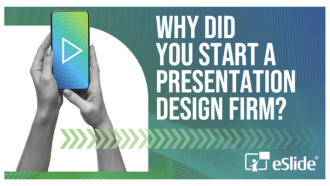The Three Essential Components of PowerPoint Design
There are three vital components to effective PowerPoint design: Structure, Economy and Emphasis. Learn how they work together to produce powerful, effective slides resulting in more successful meeting communications with eSlide Design Training.
1. Structure
Every slide that leaves our studio leaves with good structure, and the most important aspect of structure is consistency. When slides have consistency (of fonts, colors, and position of content) they can do a better job of building a connection with your audience. Visually consistent information gives the impression of being part of a single story rather than a series of individual points. And, because your audience doesn’t need to interpret every page individually, they can better focus on your message. At eSlide, before we start building slides we take the time to create a good template. This makes it easier to achieve visual consistency – even when multiple authors are working on independent sections of slides.
Good structure often results from logical and precise visual alignment. Good alignment helps to create a feeling of order on the page and organize information by grouping relevant items together. This can reduce the visual effort required to understand your information, which means your audience will more easily understand you. One eSlide design tip for ensuring correct alignment is to use PowerPoint guides.
Balance is a close cousin to alignment and refers to how things are arranged on the page. Symmetrical balance means that information is roughly equal on both sides of the page, which helps it look organized and clear. Asymmetrical balance means things are uneven and can add a feeling of direction to a slide to help to focus viewer’s eyes on important information.
2. Economy
After Structure the next critical PowerPoint design principle is Economy, which is based on the idea that “less is more”. A large display of data may be appropriate for a printed report but can be overwhelming and ineffective as a slide. For presentations it’s best to edit your information so that what remains can be more effective. Remember, PowerPoint slides are meant to be a visual accompaniment to a presenter’s verbal explanation – so some details can be removed from the slides and saved for the voice-over. If you cannot reduce the amount of content, at least divide it among several slides. It is far easier for an audience to remain attentive when you explain a topic over several slides, rather than talking to a single slide for 15 minutes.
3. Emphasis
Once you have created a PowerPoint slide presentation with good Structure and Economy, the final step is Emphasis. This is an important aspect of good PowerPoint design because it helps critical information stand out. Through the intentional use of slide design elements like color, size or even motion, you can help guide your audience’s attention to your key points – which are the things you want them to walk away remembering.








